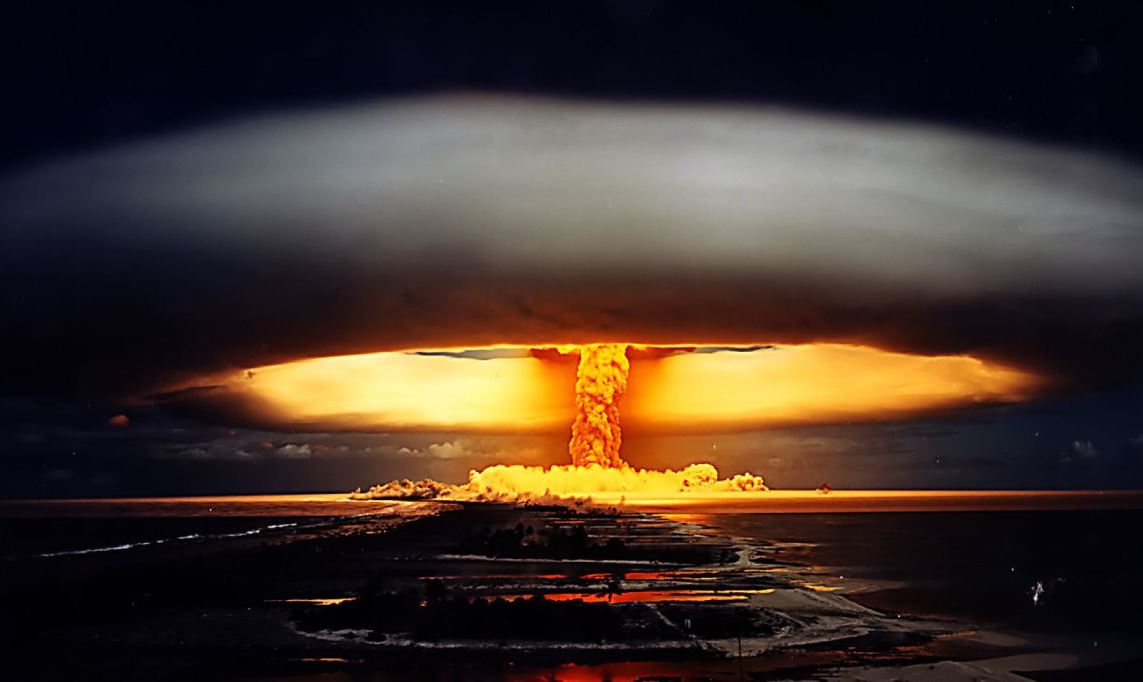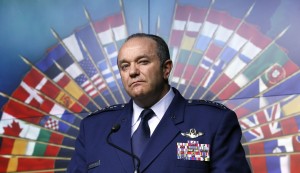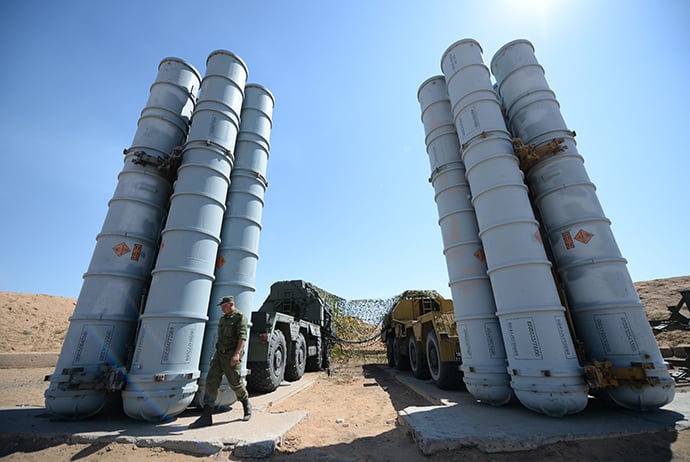
Written by Federico Pieraccini; Originally appeared at Strategic Culture Foundation
The events in the Middle East, Syria and Aleppo are the focus of global attention. Rarely has a battle been so decisive to the outcome of a war and the fate of hundreds of millions of people around the world
Hillary Clinton in the last presidential debate repeatedly called for the establishment of a no-fly zone (NFZ) in Syria. The concept, reiterated several times, clashes with the revelation contained in her private emails admitting that the implementation of a NFZ would entail the increased deaths of Syrian civilians.
 In a recent hearing before the Senate Armed Services Committee, General Philip Breedlove (image right) was asked what kind of effort would be required for the US armed forces to impose a NFZ over Syrian skies. With obvious embarrassment, the General was forced to admit that such a request would involve hitting Russian and Syrian aircraft and vehicles, opening the door to a direct confrontation between Moscow and Washington, a decision the General was simply not willing to take. The military leadership has always shown a readiness to implement the military option; so this time they must have sniffed the danger of a direct conflict with Moscow.
In a recent hearing before the Senate Armed Services Committee, General Philip Breedlove (image right) was asked what kind of effort would be required for the US armed forces to impose a NFZ over Syrian skies. With obvious embarrassment, the General was forced to admit that such a request would involve hitting Russian and Syrian aircraft and vehicles, opening the door to a direct confrontation between Moscow and Washington, a decision the General was simply not willing to take. The military leadership has always shown a readiness to implement the military option; so this time they must have sniffed the danger of a direct conflict with Moscow.
The Kremlin has publicly admitted to deploying in Syria the S-400 (image below) and S-300V4 advanced anti-aircraft and anti-missile systems respectively. The presence of the defense complex was intentionally announced as a factor of deterrence and is a logical strategy. The message to Washington is clear: any unidentified object in Syrian skies will be shot down.
The United States bases much of its military strength on the constant need to project power, making its opponents believe that it possesses capabilities that others do not hold. Therefore it is very unlikely» that the Pentagon would want to reveal to the world the worth of their stealth systems and their «legendary« American cruise missiles when faced with the S-300V4 or S-400. The Kosovo War serves to remind of the F-117 that was shot down by Soviet systems (S-125) dating from the 1960s.
Hillary Clinton’s threats against Moscow were not the only ones. The present policy makers in Washington continue to make aggressive statements demonstrating their total loss of touch with reality. In recent weeks, hysterical reactions were recorded by the Pentagon, the State Department, top military generals, and even representatives of American diplomacy. To emphasize the unhappiness prevalent in some Washington circles, several articles appeared in The Washington Post and The New York Times calling for the imposition of a US no-fly zone in Syria, ignoring the consequences highlighted by Dunford. There are two hypotheses under consideration: hitting the Syrian army air bases with cruise missiles, or the use of stealth planes to bomb Damascus’s A2/AD installations.
Behind Washington’s frantic reactions and vehement protests is the probability of military defeat. The US does not have any ability to prevent the liberation of Aleppo by the Syrian Arab Army (SAA) and the Russian Federation. In the last fifteen days, the SAA and Russia have achieved significant progress, and it is this that has led to an escalation of tensions. Some of the most significant episodes reflecting this over the last few days include: jets of the international coalition hitting the SAA, causing 90 deaths; US government officials threatening Russia with the downing of her planes and the bombings of her cities, resulting in Russian civilian deaths; and the blaming of Moscow for an attack on a humanitarian convoy.
The climax seemed to have been reached at the United Nations where the US representatives prevented a Russian resolution condemning the terrorist attacks on the Russian embassy in Damascus. It is interesting to note that fifteen years after the attacks of September 11, 2001, Washington finds itself defending Al Nusra Front (AKA Al Qaeda) in an official United Nations meeting; something to ponder. But apparently there is no limit to provocations, and a few days after this incredible denouement, the Pentagon was keen to point out that the possibility of a preventive nuclear strike against Russia is still valid.
It therefore seems almost simplistic to emphasize that because of the success of the SAA, Washington, Ankara, Riyadh, Doha and Tel Aviv are showing unprecedented signs of weakness and nervousness. Their commitment to overthrowing the legitimate government of Assad has failed. The combined action of the Syrian and Russian ground, air and sea forces pushed Washington and the corporate media to move from words of condemnation to increasingly open threats.
Last month the situation against the terrorists quickly changed in the north of Syria thanks to the Syrian Arab Army and its allies supported by the West. In Aleppo, the SAA continues to work every day with great success toward the city’s liberation. Neighborhoods and large areas are back under government control. The relentless advances of the troops loyal to Assad are altering the course of the war in Syria in favor of Damascus, eliminating the US attempts to remove the legitimate Syrian government. A victory in Aleppo would mean the near certainty of defeat for the terrorists in the remaining areas of the country. The closing of the border with Turkey would cut the supply lines, with consequences and repercussions throughout Syria.
What would still remain open are a few crossing areas in the south of the country near the border with Jordan that have always been a supply source for terrorists. However, it would be very difficult for this supply line alone to sustain the conflict or adequately replace the one closed north of Aleppo. Especially in the north through Turkey, and to the west through the uncontrolled border with Iraq, the terrorists receive continuous supplies. The liberation of Mosul by the Iraqi army, Aleppo by the SAA, and Der Al-Zur in the near future, will pave the way for the strategic recapture of Raqqa, the last bastion of Daesh, thereby defeating even the Plan B to partition the country.
With the failure of the northern front, the terrorists will be faced with the probable prospect of the complete collapse of their operations nationwide. Some will continue to fight, but most will throw away their weapons knowing that they have lost the war. Once this is achieved, the liberation of the rest of Syria should be a matter of a few months. It should be remembered that the recapture of Aleppo would guarantee a crushing defeat for the regional sponsors of international terrorism (Qatar and Saudi Arabia).
Still, it is not only the advance of Aleppo that is cause for concern for enemies of Syria. Obama and his administration are now irrelevant, also because of one of the most controversial presidential elections in recent history. The uncertain future of Washington’s foreign policy has prompted partners such as Riyadh, Doha, Ankara and Tel Aviv not to hesitate in further adding fuel to the Syrian conflagration, worried about any future inactivity from Washington and eager to advance their own military solution to the conflict.
In the case of Ankara, the invasion of Iraq and Syria is a serious danger that risks plunging the region into further chaos and destruction, with the Iraqi prime minister not hesitating to label the Turkish move reckless and warning of the conflict expanding into a regional conflict. Saudi Arabia’s problems are even greater, as it does not have the ability, in terms of men and means, to intervene directly in Syria because of its disastrous involvement in the war in Yemen. The speed with which confidence in Riyadh is crumbling is unprecedented. Her large currency reserves are dwindling, and it seems it is because tens of billions of dollars have been squandering in financing the military action against Yemen. Another example of independent military action concerns Israel.
Four years into the Syrian conflict, Israel continues its secret war against Hezbollah and Iranian troops, who are engaged in areas bordering Israel in fighting al-Nusra Front and Daesh. For Tel Aviv, there are still two options desirable to the Syrian crisis, both in line with their strategy, namely, the continuation of chaos and disorder, or a balkanization of Syria. In both cases, the objective is to expand Israel’s sphere of influence far beyond the Golan Heights, which were occupied illegally years ago.
The unsuccessful attempts of Turkey, Israel and Saudi Arabia to change events in Syria have highlighted the growing strategic misunderstandings between the United States and regional partners, misunderstandings that often oblige Ankara, Riyadh and Tel Aviv to turn to the Russian Federation for confidential dialogue, since Moscow is the only player able to adjust the delicate Middle East equilibrium.
In the near future, it remains evident to Moscow and Damascus that some risks still exist, despite a well-considered overall strategy. The acceleration in the liberation of Aleppo also has an ancillary purpose that aims to minimize maneuverability for the next American administration. In a certain way, it is a race against time: Aleppo must be liberated in order to chart the way towards the end of the conflict before the next US president comes into office in January 2017. It is yet to be seen whether Clinton or Trump plan to go beyond Obama’s empty threats, but understandably Damascus and Moscow have no intention of being caught off guard, especially with a probable Clinton presidency.
After years of negotiations with the schizophrenic diplomacy of the US, Moscow and Damascus have decided to protect themselves against any sudden decisions that may come from the American «deep state». Deploying the most advanced systems existing in air defense, Moscow has called Washington’s bluff as no one has done in years. The red line for Moscow was crossed by the tragic events of September 17 in Der al-zur. The creation by the Russians of a no-fly zone over Syrian skies has been repeatedly suggested. But incredibly, in the hours immediately after the cowardly attack against Syrian troops, the US Department of Defense and the State Department proposed the creation of a no-fly-zone that would serve to ground Russian and Syrian planes. It was a brazen and provocative proposal for Damascus and Moscow if there ever was one.
Sensing the danger in these words, Moscow acted immediately, deploying cutting-edge systems to protect Syrians skies with equipment that can shoot down cruise missiles, stealth aircraft, and even ballistic missiles (S-300 and S-400). To make sure Washington fully understood the message, the Russian Ministry of Defence (MoD) reiterated what was already publicly announced, namely that any unidentified object would be shot down immediately, as there would not be any sufficient time for Russian operators to verify the original launch, trajectory and final target of any objects detected. It is a clear warning to the US and its long-standing strategy that requires the use of large amounts of cruise missiles to destroy anti-aircraft systems in order to pave the way for a no-fly zone as was seen in Libya.
The Russian MoD has even specified that American fifth-generation stealth aircraft could be easily targeted, alluding to a radius of operation of the S-200 systems, S-300 and S-400 (and all variants) that would surprise many international observers. This statement also seems to indirectly confirm another theory that remains pure speculation, which is that during the September 17 attack by the US on the SAA in Der Al-Zur seem, some jets from the international coalition were targeted by Russian or Syrian air-defense systems (perhaps S-200s or S-400s), forcing the airplanes to retreat before facing the prospect of being shot down.
Whatever the intentions that are hidden behind Washington’s hysterical threats, Moscow has suggested several asymmetrical scenarios in response to a direct attack on its personnel in Syria. In addition to the S-300 and S-400 systems, the MoD has openly declared its knowledge of the exact locations of US special forces in Syria, a clear reference to the Syrian and Russian ability to strike US soldiers operating alongside terrorists or moderate rebels.
All of Major-General Igor Konashenkov’s recent press conferences have clearly shown new systems deployed in Syria for air defense, a more than intentional advertisement. Aside from deterrence continuing to be one preferred instrument adopted by Moscow, the unusually strong, direct and unambiguous words of the Russian MoD easily show how the patience of Moscow and Damascus has been exhausted, especially following the recent sequence of events as well as repeated threats.
In such a scenario, the US can only rely on one weapon: complaints, threats and hysterical crying amplified by the mainstream media, generals and the official spokespeople of dozens of agencies in Washington. Nothing that can actually stop the liberating action of the SAA and its allies.
The United States has no alternatives available to prevent an outcome to the conflict that is undesirable for it.
Whichever route it chooses, there is no way to change the events in Syria. Even American generals had to admit that a no-fly zone in Syria is out of the question. It is easy for US State Department spokesperson Admiral Kirby to launch empty threats, but it is more difficult for the military to act on these threats while avoiding a nuclear apocalypse. Whatever the outcome of the upcoming presidential elections, the war in Syria for the United States and its regional partners is irretrievably lost, and the hysteria and provocations of recent weeks is symptomatic of the frustration and nervousness that has not been common for Americans in recent years.






